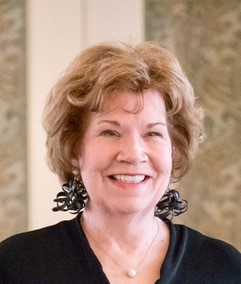
Name: Pamela Meadowcroft, PhD
Hometown: Pittsburgh, Pennsylvania
How did you first become acquainted with the Eye & Ear Foundation (EEF)?
After retiring from a career as a research psychologist, evaluating and promoting innovative mental health/social services for troubled children and their families locally and nationwide, I found myself attracted to ARCS Foundation- Pittsburgh Chapter. ARCS Foundation Inc. is a national organization with 15 chapters of volunteer women philanthropists with a mission of advancing science in America by supporting local universities’ nationally recognized research areas through ARCS Scholar Award funds for entering PhD students. Through ARCS, I met Dr. José-Alain Sahel shortly after he arrived in Pittsburgh to serve as the Chairman of Ophthalmology for the University of Pittsburgh. He inspired my entry into the remarkable work and mission of the Eye & Ear Foundation.
Why do you support the Eye & Ear Foundation?
For me, philanthropy is personal. I am particularly drawn to two EEF areas: restoration of the optic nerve (and in general vision and hearing restoration research) and Pittsburgh CREATES. My mother, a voracious reader, began losing vision in her mid-60s. She used a large magnifying light to read — not at all portable. When I introduced her to books on cassette tapes with a gift of an early cassette tape recorder, you would have thought I saved her life. Decades later, one of my sisters is now losing sight due to auto-immune complicated glaucoma. She and I have watched in amazement the EEF Webinars related to vision restoration.
Further, I am considered a one-eye-sighted older person (with challenging vision in one eye resulting from amblyopia and strabismus at birth with only tepid intervention success). Thus, any common age-related eyesight interventions (such as cataract surgery and possible glaucoma) generate even more anxiety. My link to Eye and Ear goes back to the late 1960s when I became a patient of Dr. Dorothy Christie Scott, the first female resident in the 1950s at the former Eye and Ear Hospital of Pittsburgh. She was the first physician to explain my sight condition, and limitations, in ways that I could understand.
Through my career and as a volunteer with ARCS, I have long appreciated the combination of scientific innovations, industry, and philanthropy. At EEF, they have it all. EEF’s Pittsburgh CREATES serves as incubation of next-generation medical devices, including expanding access to cutting-edge treatments through such devices. I have toured the CREATES labs and viewed prototypes for remote surgery that enable highly trained surgeons’ expanded reach (literally thousands of miles from the patient). I have “virtually toured” an individual’s insides using a device developed for improving diagnostic practices. The CREATES’ partnerships between scientists/physicians, inventors/engineers, and industry/philanthropy enable entrepreneurial scaling-up of the Department of Otolaryngology innovations now and into the future.
Finally, the EEF “community and culture” drew me personally closer. As an ARCS volunteer, I had the good fortune of meeting and working with EEF staff on our members’ educational events. The vibrancy, fun, clarity-of-purpose, professionalism, support, and sincerity that I had experienced with Dr. Sahel the first time I met him was present in all my interactions with all of EEF. While my volunteer work focuses on learning about science innovations, for me having fun while doing so is another reason I support EEF.
What excites you the most about the work of the Eye & Ear Foundation?
I am incredibly excited that the Departments of Ophthalmology and Otolaryngology at the University of Pittsburgh is poised to be the world leader in vision and hearing restoration. From the world-class talent being recruited to the University; the opening of the Vision Institute at the UPMC Mercy Pavillion in early 2023; it’s technology, training, sustainability innovations with Pittsburgh CREATES; its advancements in patient care and access; and as a critical player in Pittsburgh’s Life Sciences Innovation network, the work of the Departments and EEF will have an increasingly significant impact on the quality of life within our local community, as well as the world. This is the right time to be involved with EEF for me!
What research or breakthroughs do you hope to see in the future?
The optic nerve restoration is groundbreaking for many vision disorders and will remain an area of peak interest for me. I will also watch for converting discoveries into accessible practices as quickly as possible and continuing to bring together the physician/scientist, inventors/engineers, and industry/philanthropy communities to enable medical breakthroughs accessible to many.
If you would like to learn more about the Foundation or help me support this essential research, please contact the Eye & Ear Foundation’s CEO, Lawton Snyder at 412-864-1300.
Or, to make a donation click below:
The Eye & Ear Foundation offers insightful resources to learn more about the research advances and educational efforts within our departments. Register for our Sight + Sound Newsletter, Blog, and Webinars below to learn about our research advances. You can also like and follow EEF on Facebook, Twitter, and LinkedIn. In addition to the resources listed below, the Foundation would be happy to meet with you or schedule a tour to visit the research labs.
Sight + Sound Newsletter: A semi-annual newsletter featuring faculty, research, and donor stories.
Sight + Sound Blog: A weekly email blog featuring a clinician or scientist and details on their current research.
Sight + Sound Bites: A webinar with EEF’s CEO, Lawton Snyder, along with a clinician and scientist team presenting their research advances and answering any questions from participants. Sign up to receive invitations to the Sight + Sound Bites Webinars.
Social Media: EEF posts updates on faculty, research advances, and articles on social media. Follow EEF on Facebook, Twitter, and LinkedIn.